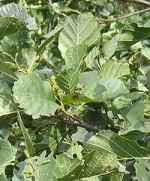 European alder , also called black alder, is a small to medium sized deciduous tree native to Europe, northern Africa and western Asia where it grows in wet areas along rivers, ponds and lakes as well as in low swampy sites. It was brought to North America in colonial times and has since become invasive from Quebec and Ontario, south to Delaware, Tennessee, and Iowa. European alder tolerates a wide range of soils and can grow in nutrient-poor soil because of its association with nitrogen-fixing bacteria. Although European alder is important to many forms of wildlife including birds, mammals, insects, lichens, and various other plants, its tolerance for many soil types, rapid growth, and high reproductive capacity, make it a potential threat to native species. USDA Hardiness Zones 3-7
European alder , also called black alder, is a small to medium sized deciduous tree native to Europe, northern Africa and western Asia where it grows in wet areas along rivers, ponds and lakes as well as in low swampy sites. It was brought to North America in colonial times and has since become invasive from Quebec and Ontario, south to Delaware, Tennessee, and Iowa. European alder tolerates a wide range of soils and can grow in nutrient-poor soil because of its association with nitrogen-fixing bacteria. Although European alder is important to many forms of wildlife including birds, mammals, insects, lichens, and various other plants, its tolerance for many soil types, rapid growth, and high reproductive capacity, make it a potential threat to native species. USDA Hardiness Zones 3-7
The following native are recommended as alternatives:
Speckled Alder (Alnus incana subsp. rugosa)
This thicket-forming shrub or small tree is native to wet soils around ponds, streams, and ditches from Labrador to Alaska and British Columbia, south to Virginia, Iowa, New Mexico, and California. Hardy in USDA zones 2-7.
Smooth Alder (Alnus serrulata)
More heat tolerant than speckled alder, this multistemmed shrub is native from Nova Scotia, south to northern Florida, and west to Nebraska and Texas where it grows in consistently moist soil. Hardiness USDA zones 5-8
Red Alder (Alnus rubra)
A wetland species reaching 50-80 feet tall, this deciduous tree is native to western North America from southeastern Alaska, to western British Columbia, south to coastal mountains of California, Washington and Oregon, east to Idaho and Montana. It is the largest alder and very wildlife friendly. Hardiness USDA zones 4-7
River Birch (Betula nigra)
This medium to large deciduous tree is native to low woods, streams and river edges from Massachusetts and southeaster Minnesota, south to northern Florida and east Texas. It features exfoliating bark, and yellow fall color. Hardiness USDA zones 4-9
Paper birch (Betual papyrifera)
This northern species of birch has snow-white bark and bright yellow foliage in fall. It is intolerant of hot nights and high humidity and is native from Newfoundland to Alaska, south to new Jersey, Indiana, and Washington. Hardiness USDA zones 2-6
Sweet Birch/Black Birch (Betula lenta)
With shiny red-brown bark and good yellow fall color, this medium sized tree is a good shade tree for parks and large spaces. It is native to eastern North America from southern Maine west to southernmost Ontario, and south in the Appalachian Mountains to northern Georgia. Hardiness USNA zones 3-7
Allegheny Serviceberry (Amelanchier laevis)
The fragrant spring blooming flowers of this deciduous shrub or small tree make it a pleasant addition to a spring garden where it will also contribute red- orange foliage color in the fall. It is native to eastern US from Nova Soctia and Ontario, south to Georgia and Iowa.
Quaking Aspen (Populus tremuloides)
Native to woodland edges, old fields, and clearings from Newfoundland to Alaska and British Columbia, south to Pennsylvania and Iowa, and the mountains of New Mexico and California, this medium sized deciduous tree has leaves that tremble in the slightest breeze and turn yellow in fall. Hardiness USDA zones 1-7